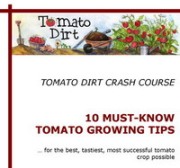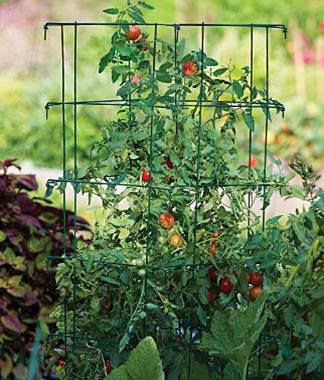Staking Tomatoes Gives You a Healthier, More Productive Crop
Since 2010, Tomato Dirt has garnered 4.8+ million views, making it the web’s leading online source for growing tomatoes in the home garden. Award-winning writer and Tomato Dirt owner Kathy Widenhouse has helped thousands of home gardeners grow healthier tomatoes. Be one of them when you get Tomato Dirt’s Growing Guide here.
Updated 5.13.24
It’s true – staking tomatoes takes a little bit of work.
But it has distinct advantages that help you have a healthier, bigger crop.
Plus, some types of tomato staking are taken care of once, early in the season – and then you’re done.
Tomatoes grow vigorously. They continually send up new stems, branches, and blossoms.
Indeterminate tomato varieties (those which keep growing and producing fruit all season until frost) are most in need of staking.
Determinate tomatoes (those which stop growing at a certain size and set their fruit at one time) have a more bushy habit, and may not need to be staked.
Advantages to staking tomatoes
- Space. Staked tomatoes grow upright, rather than sprawled, which saves garden space.
- Bigger fruit. Staking allows more light to blossoms and leaves. In addition, some gardeners prune staked plants. The plant invests the extra energy into the fruit.
- Earlier fruit. Staked tomatoes have more leaves open to the sun, which allows the plant to manufacture more energy sooner. Blossoms have energy they need to set fruit earlier.
- Healthier fruit. Staking keeps tomatoes off the ground. That makes it more difficult for pests to attack plants and keeps fruit from rotting as easily.
- Better air circulation. By staking, you allow air to move in and around branches, which keeps diseases from spreading.
- Accessibility. Staked tomatoes are easier to pick.
Disadvantages to staking tomatoes
- Time. Staking, tying, training, caging, and pruning are labor-intensive.
- Cost. Initially, stakes, cages, and ties are added expenses, although they can be used over and over each year.
- Mulch. Staked tomatoes grow upright. Exposed ground retains water best when mulched.
- Water. Staked tomatoes are erect and more vulnerable to wind, drying, and sun scald. They need more frequent watering.
Ways to stake tomatoes
- Tomato stakes: posts or poles inserted next to tomato plant to which branches are tied for support.
- Tomato cages: pre-made or formed wire mesh cylinders that encircle and support tomato plants. (Check out different tomato cages to find the right ones for you and your garden.)
- Tomato trellises: wires or rope dropped from a line between posts which provide support.
- Tomato spirals: heavy gauge steel wire that provides support through an upward twisted coil.
More on staking tomatoes
5 Ways to Stake Tomatoes ...
How to stake and tie tomatoes for support ...
How to tie up tomato plants ...
How to build tomato cages for support ...
Homemade tomato cages for short season tomatoes ...
How to build a tomato trellis for staking tomatoes ...
3 Do-It-Yourself Tomato Trellis Ideas ...
Review: Tomato Cages from Gardener's Supply ...
The perfect tomato staking tape ...
More staking tips on our Pinterest board ...
More on growing tomatoes
Growing tomatoes: top 4 areas of tomato care ...
How and when to mulch tomatoes for best tomato care
What's the best mulch for growing tomatoes?
How to control weeds in the tomato garden ...
How to use tomato fertilizer for best tomato production
Kinds of tomato fertilizer ...
Organic tomato fertilizer: advantages and disadvantages...
Watering tomato plants: the basics ...
Watering tomatoes: FAQs (Frequently Asked Questions) ...
Techniques for watering tomato plants ...
Pruning tomato plants: how and when to do it ...
Best tomato growing tips: readers share their favorites ..
Return from Staking Tomatoes to Tomato Dirt home
As an Amazon Associate and Rakuten Advertising affiliate I earn from qualifying purchases.
SHARE THIS PAGE:
FREE! 10 Must-Know Tomato Growing Tips: 20-page guide
Get yours here:





New! Comments
Have your say about what you just read! Leave a comment in the box below.